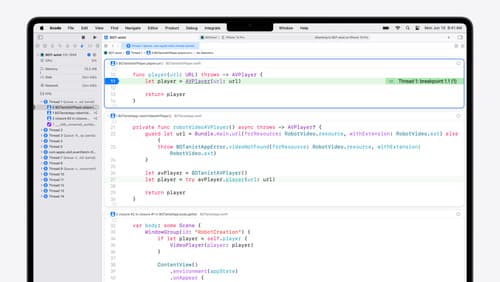swift concurrency
Asked on 2024-08-05
16 searches
Swift concurrency was a significant topic at WWDC 2024, with several sessions covering various aspects of it. Here are some key points:
-
Data Race Safety:
- Swift 6 introduces complete data race safety by default, turning potential data race issues into compile-time errors. This ensures that your app is more secure and reduces debugging time (What’s new in Swift).
- The Swift 6 language mode fully verifies data race safety at compile time, requiring values shared between concurrency domains to be sendable (A Swift Tour: Explore Swift’s features and design).
-
Actors:
- Actors are a feature in Swift that help manage shared mutable state safely. They are similar to classes but provide concurrency safety guarantees (A Swift Tour: Explore Swift’s features and design).
- Using actors can help avoid data races by isolating state within an actor, ensuring that only one task can access the state at a time (What’s new in Swift).
-
Concurrency Features in Swift 6:
- Swift 6 includes new low-level primitives for synchronization, such as atomics and mutexes, which provide efficient, lock-free implementations and ensure mutually exclusive access to shared resources (What’s new in Swift).
- The synchronization module introduces these primitives, which are generic over any type and should be stored in
letproperties for safe concurrent access (What’s new in Swift).
-
Migrating to Swift 6:
- When migrating to Swift 6, you may encounter warnings or errors related to concurrency. For example, ensuring that delegates and other protocols are correctly isolated to the main actor (Migrate your app to Swift 6).
- The migration process involves enabling Swift 6 language mode and incrementally adopting new concurrency features to ensure data race safety (Migrate your app to Swift 6).
-
Practical Examples:
- The sessions provided practical examples of using Swift concurrency, such as handling asynchronous tasks with
async/awaitand ensuring data race safety in a server environment (A Swift Tour: Explore Swift’s features and design).
- The sessions provided practical examples of using Swift concurrency, such as handling asynchronous tasks with
Relevant Sessions
These sessions provide a comprehensive overview of Swift concurrency, including new features, migration strategies, and practical examples.

Migrate your app to Swift 6
Experience Swift 6 migration in action as we update an existing sample app. Learn how to migrate incrementally, module by module, and how the compiler helps you identify code that’s at risk of data races. Discover different techniques for ensuring clear isolation boundaries and eliminating concurrent access to shared mutable state.

What’s new in Swift
Join us for an update on Swift. We’ll briefly go through a history of Swift over the past decade, and show you how the community has grown through workgroups, expanded the package ecosystem, and increased platform support. We’ll introduce you to a new language mode that achieves data-race safety by default, and a language subset that lets you run Swift on highly constrained systems. We’ll also explore some language updates including noncopyable types, typed throws, and improved C++ interoperability.

What’s new in Xcode 16
Discover the latest productivity and performance improvements in Xcode 16. Learn about enhancements to code completion, diagnostics, and Xcode Previews. Find out more about updates in builds and explore improvements in debugging and Instruments.
